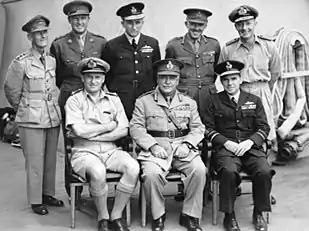George Dunbar Moore
Rear Admiral George Dunbar Moore, CBE (10 October 1893 – 27 July 1979) was a senior commander in the Royal Australian Navy and a diplomat.[1]
George Dunbar Moore | |
|---|---|
 Rear Admiral George Moore c. 1945 | |
| Born | 10 October 1893 Springsure, Queensland |
| Died | 27 July 1979 (aged 85) Darlinghurst, New South Wales |
| Allegiance | United Kingdom Australia |
| Service/ | Royal Naval Reserve (1912–13) Royal Australian Navy (1913–50) |
| Years of service | 1912–1950 |
| Rank | Rear Admiral |
| Commands held | Flag Officer in Command New South Wales (1947–50) Naval Officer in Command Sydney (1944–47) HMAS Canberra (1941–42) HMAS Australia (1941) HMS Dauntless (1939–41) HMS Curacoa (1939) HMAS Stuart (1937–38) HMAS Yarra (1936–37) HMS Dunoon (1932–34) |
| Battles/wars | First World War Second World War |
| Awards | Commander of the Order of the British Empire |
| Spouse(s) | Doretta Ziele Russell
(m. 1923) |
| Other work | Australian Minister to the Philippines (1950–55) |
Moore was appointed Australia's first Minister to the Philippines in 1950, leaving his position as naval flag officer in charge of Sydney to take up the post in Manila.[2][3] In 1954, Moore made front-page news in the Philippines when local media claimed he lashed out at security officers at his residence.[4] Moore retired from the position a year later in July 1955.[5]

Moore (seated, left) with General Sir Thomas Blamey (seated, centre) and other Australian delegates at the Japanese surrender aboard USS Missouri, September 1945
References
- Royal Australian Navy, Rear Admiral George Dunbar Moore, Australian Government, archived from the original on 13 November 2016
- "Admiral Moore for Philippines". The Canberra Times. 20 May 1950. p. 4.
- "Successor to Admiral Moore Appointed". Illawarra Daily Mercury. 22 May 1950. p. 3.
- Rivett, Rohan (7 September 1954). "The Filipino Army was "insulted": Our Admiral shouted at hungry guard". The Argus. p. 1.
- "New Minister to Philippines". The Canberra Times. 1 June 1955. p. 2.
| Diplomatic posts | ||
|---|---|---|
| Preceded by Keith Waller as Consul-General |
Australian Minister to the Philippines 1950–1955 |
Succeeded by Mick Shann |
This article is issued from Wikipedia. The text is licensed under Creative Commons - Attribution - Sharealike. Additional terms may apply for the media files.